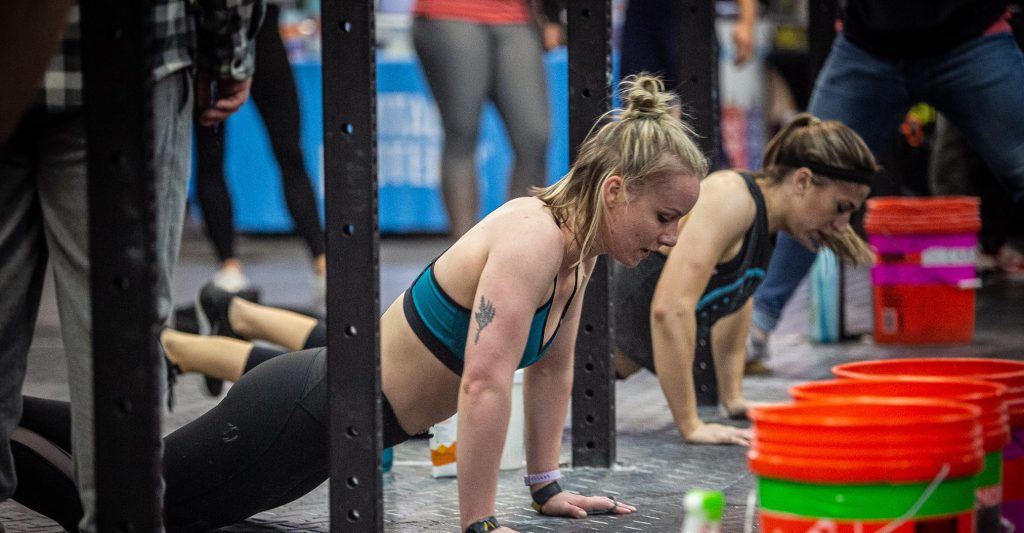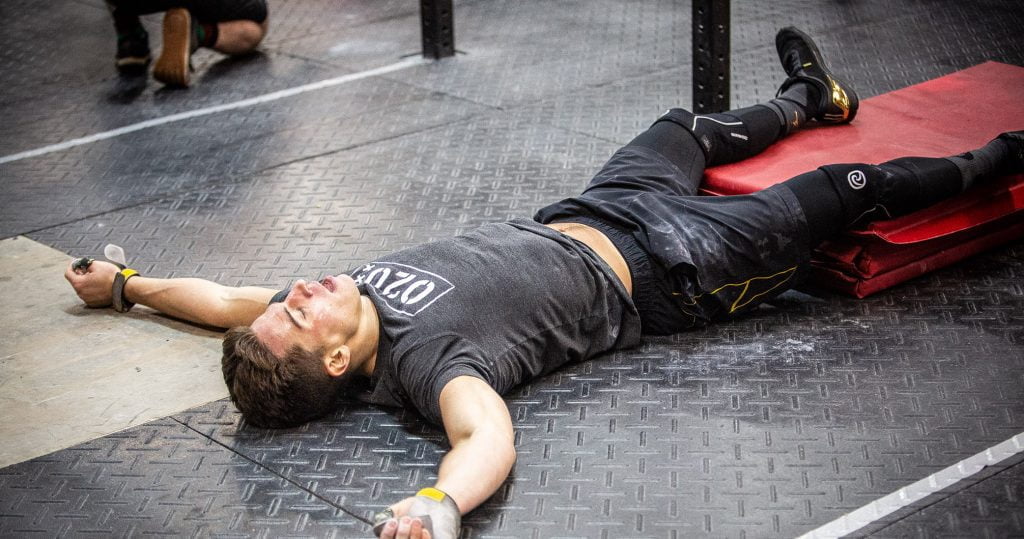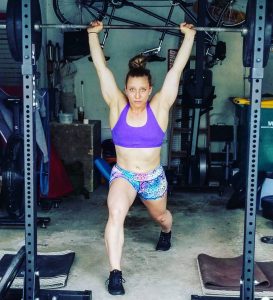With a lot of people training at home, a lot of people are just trying to maintain their fitness.
But, some are actually looking to get better and improve while their training options are limited.
In this post, we’ll break down a theoretical progression for how to improve your conditioning and develop the ability to do high volume of specific movements in workouts without falling apart.
This 5 step progression is something that you can take and use right away, or something that you can use as a framework to craft your own training sessions.
We’ll use the example of burpees and we won’t assume that you have more available than a few pieces of equipment and the ability to either run, row or bike.
That said, you can apply the same principles to just about anything that you want to improve: handstand push-ups, toes-to-bar, wall balls, and more.
We’ve followed similar progressions with many of our coaching clients, and have seen people go from being “hit or miss” on their abilities to do movements in workouts to consistently Rx-ing difficult, Open-style workouts with high volumes of difficult movements.
Let’s get started.

Why do I fall apart on [insert your least favorite movement here] in workouts?
It’s a common refrain that we hear from clients all the time.
“I can do [insert movement here] ok sometimes, but I fall apart when I have to do it when I’m tired.”
This is an issue for CrossFitters at all levels – from beginners who have just started trying to Rx workouts to CrossFit Games athletes.
In fact, the ability to keep working sustainably while tired is probably the most important thing that separates the best CrossFit athletes from everyone else.
So, what’s going on?
Without getting too technical (you can check out my podcast with Evan Peikon from Training Think Tank if you want to get into the weeds on fatigue mechanisms for CrossFit athletes), different types of workouts and movement pairings can make it more or less difficult to keep moving when you’re tired.
This isn’t just about movements using the same muscle groups – everyone knows it’s harder to do handstand push-ups after a bunch of shoulder-to-overhead and it’s harder to do goblet squats after a bunch of jumping switch lunges.
We also need to understand how to progress the difficulty of what we’re working on.
The most basic thing we can do is work on movements in scenarios where we can control the pacing and rarely have to exceed a repeatable volume of a movement (think something like an EMOM or intervals with small, sustainable sets of our target movement).
The most advanced thing we can do is throw a bunch of different movements together with high volume sets, lots of demand on the same muscle groups, and no built-in rest (think almost every CrossFit Games Open workout).
So, let’s use the humble burpee for our theoretical progression.

How much volume should I do for a specific movement?
Most CrossFit workouts have a typical volume of certain types of movements.
The classic 21-15-9 rep scheme that makes up workouts like Fran, Diane and Elizabeth is 45 reps of each movement.
If we look at Open workouts from years past, we can see that we’re often expected to do somewhere around 150 wall balls, 100 burpees, 30 muscle-ups, and 150 dumbbell snatches.
There are certainly outliers – 14.2, a couplet of chest-to-bar pull-ups and overhead squats, had top athletes getting well over 150 reps of chest-to-bar pull-ups.
But, we can use rough guidelines based upon past workouts, as well as a spot check on your current capacity to decide how many reps to do in a given training session.
For example, if you’re just getting muscle-ups, it is probably unreasonable to expect to be doing 30+ reps in a training session. Instead, focus on accumulating as much volume as you can without total breakdown in your capacity.
For the burpee, we will use a volume of 100 reps for our example progression.
Let’s look at some actual training sessions.
Step 1: Short Intervals with Small Sets of our Target Movement
As we said before, an EMOM (Every Minute on the Minute) structure is a great way to start accumulating volume in a given movement pattern.
It allows us to build in rest, it keeps the sets relatively small, and – if we alternate our target movement with cyclical or monostructural efforts – we can build in pacing and an opportunity to reduce muscular tension and restore blood flow throughout the body.
Here’s an EMOM session focused on accumulating 100 burpees while alternating with running, rowing or biking.
EMOM 10:
1st: 10 burpees
2nd: 30s row/bike/run
+
(Rest 5 min)
+
EMOM 10:
1st: 10 burpees
2nd: 30s row/bike/run
In this example, the pace on running, rowing or biking should be dictated by the ability to maintain output on the burpees.
Meaning, your pace on each interval should be consistent from the start of the session to the end. You shouldn’t be getting “more tired” and slowing down as you go.
The next step in our progression involves including movements that are more challenging and present more interference and blood flow demands on the same muscles that are working in the burpees.
In this example, we can keep the same structure as the previous session and just change the movements to include more interference from movements that use the same muscle groups as the burpee.
EMOM 10:
1st: 10 burpees
2nd: 30s DB thrusters (light)
+
(Rest 5 min)
+
EMOM 10:
1st: 10 burpees
2nd: 30s bear crawl
Again, our focus here is maintaining consistent pacing and not slowing down throughout the session or allowing the burpees to become a “slog.”
We want to modify the difficulty and the pacing of the paired movements in order to prioritize consistency and smoothness on the burpee.
Step 2: Medium-Length Intervals with Small Sets of our Target Movement
Once we can maintain output in EMOM types of scenarios, we can then progress into work/rest situations that involve longer periods of work.
It’s easiest to maintain output when pairing something like burpees with cyclical work since that allows for the most opportunity both to control pace and maintain blood flow.
So, for example, we can have a session that looks like this:
5 rounds:
10 burpees
400m row/run
10 burpees
-Rest 2-3 min
•Consistent splits per round.
The number of burpees we have to do in each set is still relatively low, and, by splitting up the burpees with a row or a run, we insert a pacing control point where we can reestablish blood flow and avoid digging too deep.
As before, the goal here is consistent splits on each interval as well as solid, smooth execution on each set of burpees.
When we are able to execute here, the next step is to make this more challenging by adding in more “interfering” movements and a little bit of CrossFit chaos.
A session at this stage might look something like this:
10 rounds:
21 assault bike/row calories
15 wall balls
9 burpees
-Rest 2-3 min
By doing the burpees last, we are accumulating some fatigue from the assault bike and the wall balls. But, the goal is to pace your effort on those movements and prioritize moving well through the burpees.
Our next step is to start training things that look more like “CrossFit.”
Step 3: “For Time” and AMRAP Scenarios with Small Sets and Pacing Control Points
This is where we start to do more sport-specific training.
While we’re not quite ready to jump into doing Open workouts, we can use cyclical modalities like running or rowing as well as movements like carries or planks to insert control points into our training.
The goal in these sessions is to maintain consistent output throughout, and to accumulate our desired volume of our target movement without breaking down or redlining.
Here’s an example:
20 min AMRAP:
10 burpees
10 assault bike calories
50’ farmer’s walk (70/hand – 53/hand)
In this session, our focus is keeping our split times for each round very similar, while making sure that our burpees in particular are solid throughout.
We want to pace the assault bike so that we’re able to come right off and get to work on the farmer’s walk, and the farmer’s walk weight should not be particularly challenging.
From there, we can make the scenarios more messy and involve more interference between movements, while still allowing for certain points of control.
We can also keep the total number of reps in a given round somewhat small so that we aren’t “blowing up” as we slog through big sets.
For example—
20 min AMRAP:
5 burpees
10 air squats
15 double-unders
While the air squats do interfere with the burpees a bit since both patterns are based upon moving through repetitive hip flexion and hip extension, the air squat is not a terribly challenging movement and we can also slow the pace down on it to make sure we’re able to execute consistent splits on each of our rounds.
Our next step is to start removing control points and adding in more interference between movements.

Step 4: “For Time” and AMRAP Scenarios with Small Sets but with Interference and Few Control Points
The best way to start training these more difficult types of workouts is to keep the volume per round low of our target movement and also avoid significant amounts of interference.
While we’re going to be removing our control points, we can try to create scenarios that enable us to work with consistent output even though we’re making the demands on our system tougher and tougher.
We don’t want to jump into full blown chaos just yet. Instead, we can design sessions that look more like typical “metcons,” but that allow us to keep moving on our target movement without breaking down in pacing or in technique.
Sometime like this would be an example of a session:
10 rounds:
8 bar-facing burpees
10 power snatches (75/55)
12 box jumps, step down (24″/20″)
This is a play on Open workout 20.1, but we are reducing the volume of burpees slightly, making the weight on the power snatches lighter, and adding in box jumps
Another example might be a more challenging version of one of our sessions from the previous section:
20 min AMRAP:
5 burpees
10 Russian KB swings (70/53)
15 wall balls
We’re still working with relatively small sets of burpees at once, but we’re adding in a lot more accumulated fatigue and interference and removing some of the pacing control points by doing heavy-ish Russian KB swings and wall balls instead of air squats and double-unders.
Step 5: “For Time” and AMRAP Scenarios with Larger Sets, Lots of Interference, and Lots of Accumulated Fatigue
We can use the CrossFit Games Open workouts as an example of this type of session.
17.1 is a great example to start with.
For time:
10 DB snatches, alternating (50/35)
15 burpee box jump overs (24″/20″)
20 DB snatches, alternating
15 burpee box jump overs
30 DB snatches, alternating
15 burpee box jump overs
40 DB snatches, alternating
15 burpee box jump overs
50 DB snatches, alternating
15 burpee box jump overs
There is a lot of interference between the DB snatches and the burpee box jump overs, and the larger sets of each movement very quickly turn into a slog.
We can also look at a chipper-style workout with big sets of each movement.
For time:
25 goblet squats (50/35)
50 burpees
25 goblet squats
300 double-unders
25 goblet squats
50 burpees
25 goblet squats
These movements all interfere with each other, and the bigger sets make it more difficult to maintain a steady pace on each section.
And, if we’re in the gym and have access to a barbell, something like 13.1 has big sets of burpees with a lot of accumulated fatigue.
17 min AMRAP:
40 burpees, 6″ target
30 snatches (75/45)
30 burpees, 6″ target
30 snatches (135/75)
20 burpees, 6″ target
30 snatches (165/95)
10 burpees, 6″ target
Each of these scenarios puts the burpee under tremendous stress and requires the ability to pace, pump blood around the body, and tolerate a lot of discomfort.

Summary and Takeaways
Understanding where you sit on this 5 step progression for a given movement can help you figure out how to improve your ability to actually do movements in workouts.
While we used the example of a burpee, we can create similar progressions for double-unders, handstand push-ups, chest-to-bar pull-ups, and muscle-ups as well.
By moving from training sessions with small sets of our target movement, low levels of interference from other movements in the workout, and lots of control points to help pacing into training sessions with lots of accumulated fatigue, lots of interference, and few control points, we can develop our capacity to keep working while we’re tired – even on our least favorite movements.




